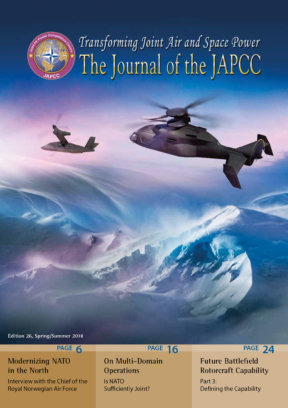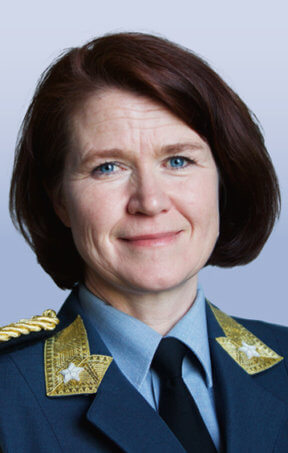What is your view, as a NATO Air Chief in the North, on our current security situation?
First, I would stress that in the European part of the Alliance we need to pay attention both to the South, East and the North. In many ways, the different regions have different challenges. However, isolated incidents in one region could inflict consequences in other regions. The challenges are interlinked; a potential threat to the Baltic regions will immediately affect the north and vice versa.
Norway considers ourselves to be the NATO gatekeeper of the north, monitoring the northern flank. Since the Cold War, Norway has kept a close eye on military strategic developments in the Barents Sea, on behalf of the Alliance. This is a huge responsibility, and we are putting a lot of effort into making sure we maintain a good situational awareness for the Alliance.
This situational awareness is of great importance, as we are the closest neighbour to the world’s largest non-western concentration of military power. The Kola Peninsula and the Arctic are of great importance to Russia’s power projection capability. The current modernization of the Northern Fleet will increase their capability, as we see a renewal of a wide range of weapon systems. This renewal will continue to have an impact on our ability to operate in all domains, should we see increased tension in the security climate.
The main task of the military forces on the Kola Peninsula is strategic nuclear deterrence. Russia continues to operate a nuclear triad consisting of strategic nuclear missiles, bomber aircraft and submarines. One of the primary areas of operations for strategic submarines is the Barents Ocean north-east of Norway, which is why Russia’s military has established the Bastion Defence, a multi-layered Anti-Access/Area-Denial (A2/AD) system with the capability to project force into the North Atlantic Ocean and to disrupt allied sea lines of communications. And I have to underline; this A2/AD capability is already established in the North and we see the same challenge in the Baltics, the Black Sea and the Mediterranean Sea. It’s forcing us to adapt our plans to the reality.
What is Norway’s answer to the changed security environment in our Northern Region?
Norway pursues the goals of predictability and stability in the north. We believe that we do this best from a position of strength. That is why we are investing in strategic capabilities that will enhance our ability to take care of security in our region. In the 2016 long-term plan for our armed forces we are investing in high-end capabilities relevant to our security requirements. Intelligence, surveillance, Maritime Patrol Aircraft, fifth-generation combat aircraft and submarines are key lines of effort in our development.
As an Air Chief I would like to mention the F-35 and the P-8 in particular:
- The F-35 with its long-range, precision-guided Joint Strike Missile (JSM) ensures that we will be able to strike even well-defended targets, both on land or at sea, at extended distances. This strengthens our ability to deter any potential opponent.
- The P-8 will ensure Norway’s ability to remain NATO’s gatekeeper in the north. Strategic surveillance and intelligence in the maritime domain are vital to NATO’s situational awareness, and therefore a high priority mission for Norway.
Norway and several of our allies are integrating fifth-generation capabilities, which give us more strategic impact. This also means that we will need to shorten our readiness time. We used to have weeks and months to prepare. Now we need to be ready in hours.
The Royal Norwegian Air Force is currently adapting in accordance with Norway’s Long Term Plan. How will this affect the Royal Norwegian Air Force?
In addition to the previously mentioned purchases, the Long Term Plan confirms the need for protected and sustainable bases. With the current technology development around us, we need to make sure that our bases are sufficiently protected. We are therefore concentrating our activity towards fewer, but more protected air bases. This starts with early warning. In the next years, Norway will purchase new long-range radars, in order to give us increased early warning.
Thereafter, we need to make sure that we can handle incoming threats. Therefore, the government has highlighted the importance of a multi-layered Ground Based Air Defence. We are also working on our Force Protection concept for our bases. All of these projects are being handled in close cooperation with the Norwegian Defence Research Establishment, which makes me confident that the decisions made today, will give us what we need for the future.
What do you see as the biggest challenge with all the fifth-generation capabilities being introduced in NATO?
From my point of view, the most important factor is our ability to make sure that our air command and control, and therefore our contribution to Joint command and control, is up to the new standards. I would specify it to two areas: System and competence.
The introduction of NATO Air Command and Control System (ACCS) will be one of the cornerstones in our NATO Integrated Air and Missile Defence System (NATINAMDS). My concern is on three main topics: Cost, time and performance. If the end product ends up being further delayed, too costly for the nations, or with a performance that will reduce the effect of our new capabilities, then we are moving in the wrong direction. We can’t have a fourth generation command and control system managing fifth-generation capabilities.
Secondly, we need to change our view on competence. Air Power has always been strategic by nature. And as our assets increase their strategic impact; our airmen also increase their strategic impact. This goes all the way from our airmen at the squadrons, to the airmen at the strategic level.
We will, therefore, need to change our mindset and look closely into how we train and educate our airmen. Fifth-generation capabilities need fifth-generation competence. This must be developed, and we also have to make sure that we have the right competence in the right position. This is especially true on the joint level, as there will be an even greater demand for air assets in the future.
With the introduction of fifth-generation assets, might this cause a change in Norway’s security policy?
Fifth-generation air assets will give more options to the politicians, but I don’t see it changing our main principles. I would say that the main lines of Norway’s security policy will remain consistent for the years to come. Our security policy is based on collective defence and credible deterrence.
Credible deterrence for Norway means standing firm with our allies, exercising our sovereign rights, and making our strategic interests clear – to remain a stable and predictable neighbour from a position of strength. Deterrence is of fundamental importance in every war-preventing strategy.
Our defence concept is based on the premise of involving allied reinforcements early on in a crisis, and as seamlessly as possible.
Allied training is therefore of vital importance to us. The Arctic Challenge Exercise is a great example of this. An exercise built on the successful cross-border training that the Nordic countries have developed into one of Europe’s largest air exercises.
In 2018 we will also host the Trident Juncture exercise in Norway. This will be a great opportunity for us to make sure that we are on the right path in the development of our ability to receive allied reinforcements. This will also be a great opportunity for our airmen to work in a joint and international environment. After all, we train, we fight, and we win together.
Where do you see the Royal Norwegian Air Force in 10 years’ time?
In ten years’ time, we will be finished with the process of phasing in most of our new capabilities, like the F-35, the P-8 and new GBAD and early warning radars. We plan to be fully operational capable (FOC) at fewer, but more protected bases than today. We will continuously work on the development of our cooperation with other forces, both nationally and internationally.
To summarize Norway’s path towards this end state, I would say that it will be demanding with such a large restructuring of our Air Force, but I’m confident that our airmen will overcome the challenges that lay in front of us. However, we must also be careful to not look far ahead only. In the shorter term, we are working hard to increase our readiness and sustainability. At any time, we must be ready to fight with what we have if deterrence fails.












